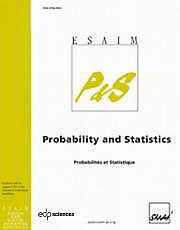Article contents
Model selection for estimating the non zero components of aGaussian vector
Published online by Cambridge University Press: 09 March 2006
Abstract
We propose a method based on a penalised likelihood criterion, for estimating the number on non-zero components of the mean of a Gaussian vector. Following the work of Birgé and Massart in Gaussian model selection, we choose the penalty function such that the resulting estimator minimises the Kullback risk.
- Type
- Research Article
- Information
- Copyright
- © EDP Sciences, SMAI, 2006
References
- 4
- Cited by




